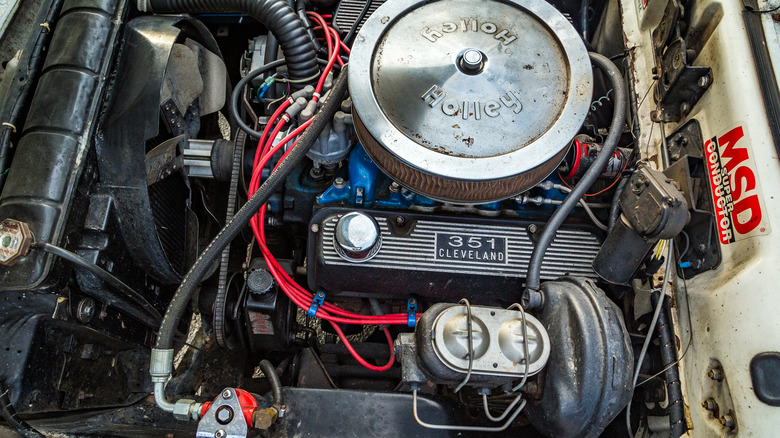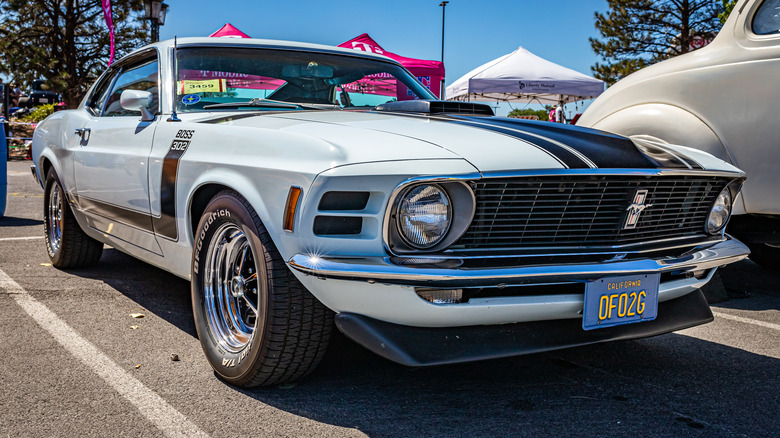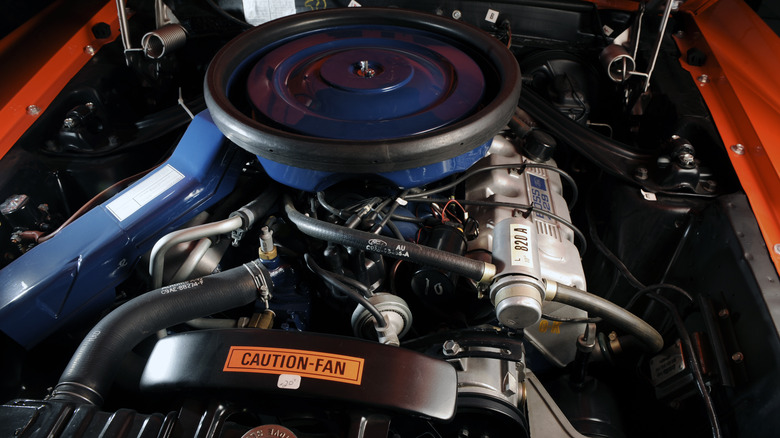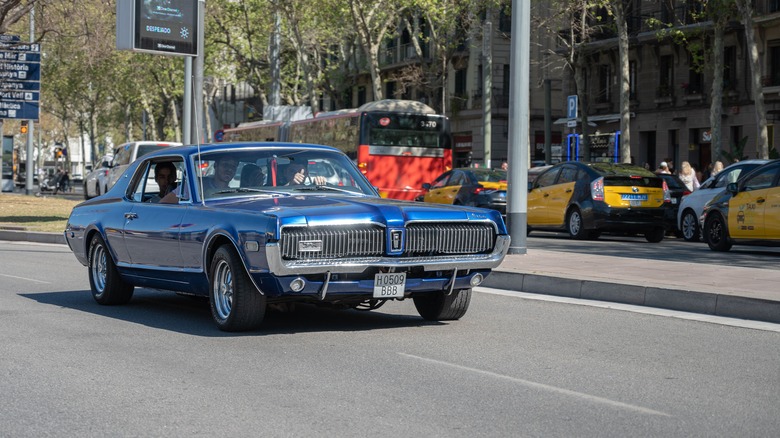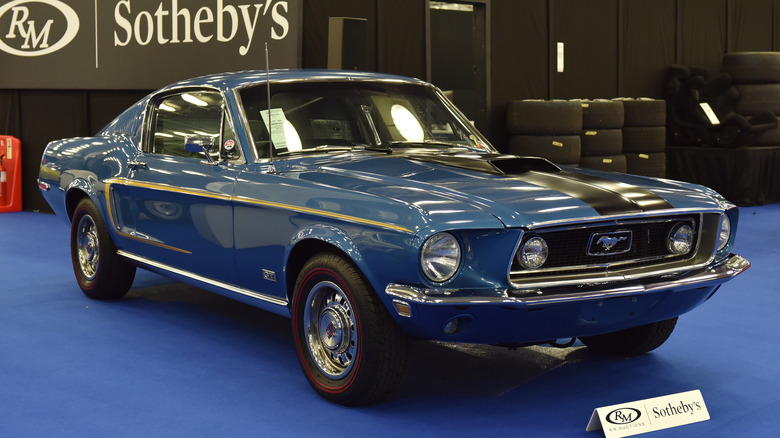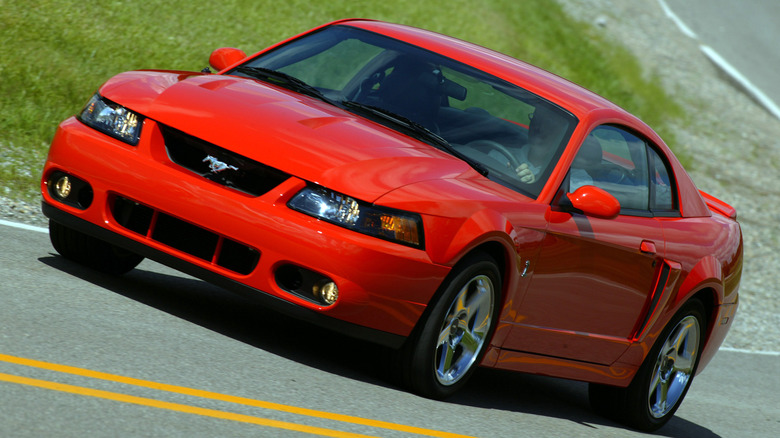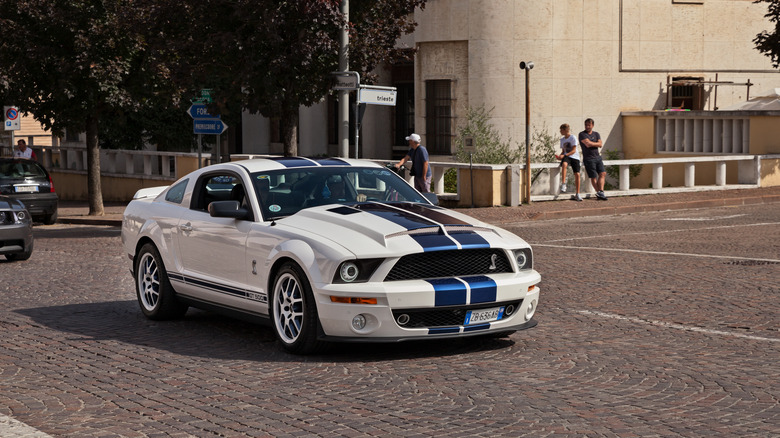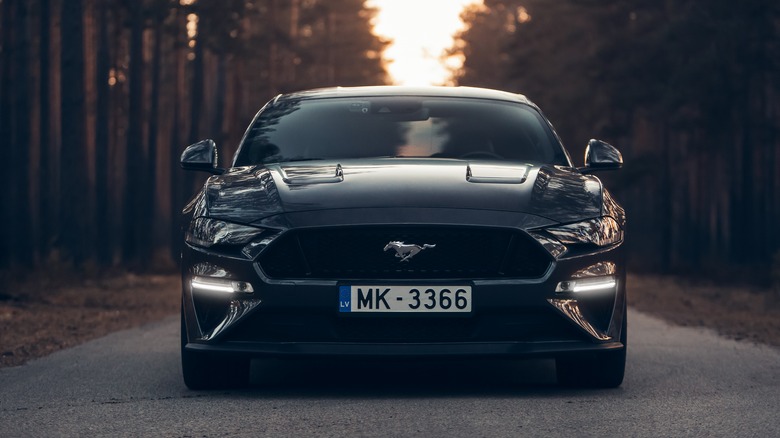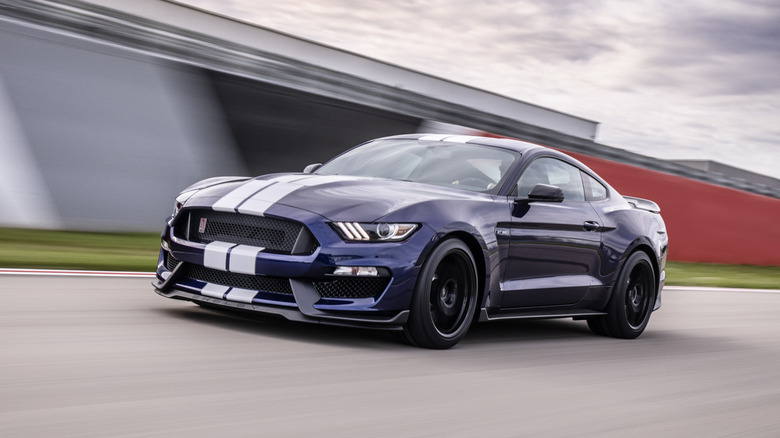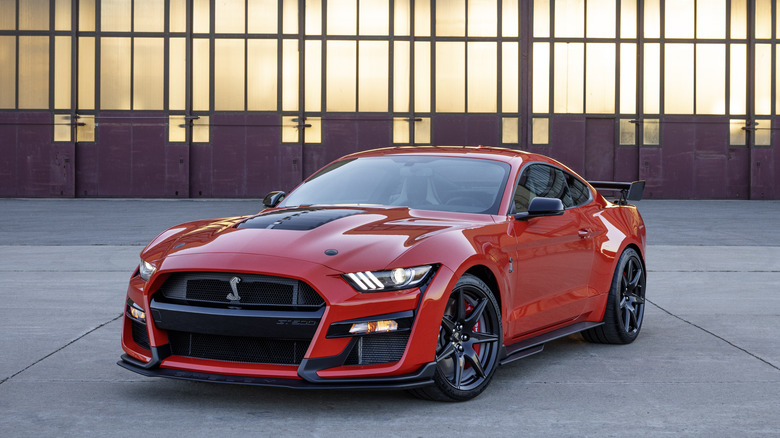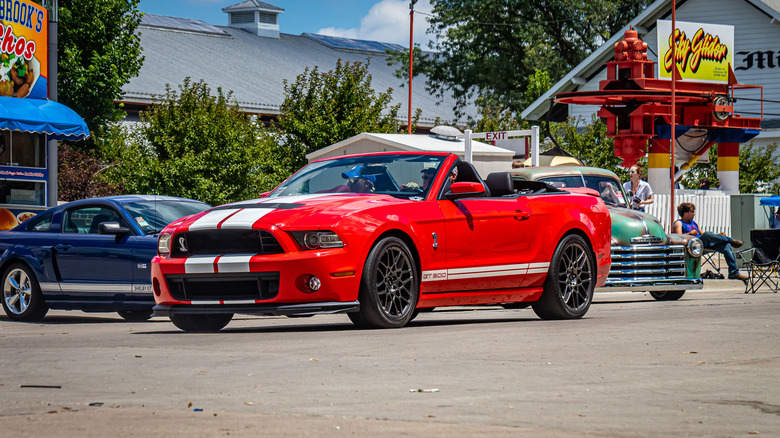10 Of The Best Engines Ever Put In A Ford Muscle Car
The Ford Mustang celebrates its 60th birthday in 2024. Naturally, Ford will mark the occasion with a special edition model. When the Mustang first hit showroom floors in 1964, the muscle car battle between the Big Three American automakers properly began, leading to the release of some muscle cars that were truly ahead of their time. While the Mustang is undoubtedly Ford's most popular muscle car, it's definitely not the only one it made over the years. Tons of different special editions of Ford's regular vehicles also got muscle versions, like the Galaxie and the Torino.
Easily the most important aspect of any muscle car, especially a classic muscle car, is the engine. Those stunning good looks don't matter much if it doesn't have a big, burly V8 engine great for doing burnouts, going fast in a straight line, and frankly, not much else. Early muscle cars didn't have great handling, though that has of course changed over the past few decades.
One thing has remained certain: Ford knows a thing or two about how to make a proper V8 engine that befits a muscle car. These engines will stand or have already stood the test of time.
Boss 302
When the Mustang first appeared in the 60s, Ford wanted to take it racing. The Mustang was always quite good at the Trans Am series, but in the late 60s, it was time to give the powertrain a pretty big overhaul. This engine had to fit into the displacement regulations, and also show the competing Camaro who was boss. Literally. Ford developed the Boss 302 primarily to take the Mustang racing, but of course, there was a road-going version too.
The original Mustang Boss 302, sold in 1969 and 1970, was named after its newly designed engine, the Boss 302. As the name implies, it displaced 302 cubic inches (or 4.9 liters), and it was rated at a decent 290 hp from the factory. This matched the figure put out by the competing Camaro Z/28, but in reality, the Boss 302 was capable of putting out way more power. Test mules from back in the day could easily push over 300 hp.
Obviously, the most notable and only application of the Boss 302 engine was the Mustang Boss 302. The super short-lived and super limited Boss 302 remains one of the most valuable Mustangs to this day, and the Boss 302 engine was an absolute rocketship both on the road and the race track. It isn't, however, the most elusive of the Boss Mustangs.
Boss 429
While the Boss 302 was meant to take the fight to the Chevy Camaro at Trans Am, the Boss 429 was designed to take on an even more serious challenge in the world of American motorsport: NASCAR. The 429-cubic inch (7.0-liter) Boss 429 V8 was based on the 385 big block family that Ford introduced in the late 60s. Its larger capacity and hemispherical heads made it clear what the goal was for the Boss 429 engine and the resulting Boss 429 Mustang: to obliterate the Dodge Charger on the speedway.
The Boss 429 featured some pretty serious engineering, like mounting the valves at a slight angle for better port angles, and aluminum heads. This engine was, at its core, designed for racing, but only the namesake Mustang Boss 429 would end up receiving it.
Ford claimed that the Boss 429 outputted 375 hp from the factory when in reality, the figure is probably closer to 500. 500 hp is plenty today, but it was a lot back in the late 1960s. Clearly, Ford was very determined to dethrone the Charger from its comfortable NASCAR lead.
351 Windsor
Older Ford enthusiasts agree that the 351 Cleveland was a pretty solid powertrain, and it's fairly easy to squeeze a lot of power out of it. However, Ford also offered another 351 cubic-inch V8 that was pretty awesome in its own right: the Windsor. This is one of the engines that found a home in some of Ford's other models in the late 60s and early 70s, such as the Galaxie and the Country Squire. Naturally, it was also available on the Mustang, as well as the Mustang's cousin, the Mercury Cougar.
First appearing in 1967, the Windsor would soldier on until 1997, switching from carburetors to fuel injection in the late 1980s. Later iterations of the Windsor also powered the original Ford F-150 Lightning, and the design served as the foundation for the engine in the bonkers supercar Saleen S7. There's a common misconception that the Windsor is related to the Cleveland, which has identical displacement, but that's the only thing the two have in common.
The most notable thing about the Windsor is its reliability. With proper and regular maintenance, you can get some serious miles out of a Windsor, and it's also very well-prepared to handle some major power gains. Handy if you're planning a restomod build.
428 Cobra Jet
Inspired by a certain Carroll Shelby and a Ford dealer installing the big block 428 V8 in their Mustangs, Ford decided to offer the Cobra Jet engine officially on the Mustang starting in 1968. The Cobra Jet was based on the FE family of big block V8s that Ford introduced in the 60s, and it was intended for the Mustang buyer who wanted to go really, really fast. The initial run of Cobra Jet powertrains could put out over 400 hp, but even the one hampered by emissions regulations put out a respectable 280 hp.
The Cobra Jet also powered the venerable Mustang Mach 1, and there was also a Super Cobra Jet derivative primarily aimed at drag racing, as evident in the fact that it was part of a factory drag pack. With over 300 hp and 400 lb-ft of torque from the factory, it was definitely no slouch, and the drag pack had much harder-wearing internals, making it very easy to tune.
Today, Cobra Jet Mustangs get all the attention, especially those with a four on the floor. However, there are other ways to have the Cobra Jet experience, often for cheaper. Ford also gave the Thunderbird, the Torino, and the Fairlane the Cobra Jet treatment. In the world of Ford, the Cobra Jet name carries such immense weight that you can still buy a crate motor with the same name today.
4.6-liter supercharged Modular V8
The SN-95 Ford Mustang arrived in 1994, and it brought along some pretty major improvements over the Fox Body that preceded it. One thing is for sure though, the SN-95 Mustang kickstarted the muscle car horsepower war that still wages today, with the Terminator Cobra. The initial SVT Cobra version was pretty good, and power picked up a little bit throughout the years. Things got serious in 2003, with the introduction of the Terminator Cobra.
Arriving during the twilight of the fourth generation Mustang, the Terminator Cobra was the frontrunner of something that would become very common in the world of muscle cars: forced induction. From the factory, the 2003 and 2004 SVT Cobras stuck a supercharger on the 4.6-liter Modular V8, which debuted on the SN-95 Mustang and replaced the old small block 5.0 liter.
The end result was 390 hp, which gave the engine a huge leg up on the previous Mustang SVT Cobra. What's more, the Terminator Cobra is known in the automotive community for how easy it is to squeeze more power out of, easily gracing 500 hp with the lightest of mods. To this day, the Terminator Cobra is one of the finest examples of the Mustang breed, and if the car is painted in the showstopping Mystichrome paint, also one of the most elusive and sought-after.
5.4-liter supercharged Modular V8
After the Terminator Cobra caused a major splash with its supercharged V8 and pretty serious power output, Ford decided to up the ante for the Mustang's fifth generation. Rather than using the SVT Cobra name, it decided to adorn the flagship Mustang with a name it deserves: Shelby. The Shelby GT500 arrived for model year 2007, and in this case, 500 referred to the claimed power output. The era of the factory 500 hp Mustang was here.
That power was made possible thanks to the much-improved powertrain under the hood. Displacing around 800cc more than the standard 4.6-liter Mustang, the 5.4-liter Modular V8 under the hood also added a supercharger for good measure, resulting in 500 hp. A pretty impressive figure, and one that was very difficult to put down thanks to the solid rear axle. Still, the GT500 did have its straight-line chops, as befits a muscle car.
The 5.4-liter supercharged V8 actually had a few things in common with the unit that powered the original Ford GT. What's more, with a supercharger from the factory, you could squeeze much more power out of it, and really get that adrenaline pumping.
5.0-liter Coyote V8
In the early 2010s, the Modular V8 family in the Mustang was consigned to the history books. In their place came an all-new aluminum V8 with 32 valves and a dual overhead camshaft setup, displacing 5.0 liters. Ford called it the Coyote V8, and it's been in service in the Mustang for over a decade now. Many consider the Coyote one of the best V8s ever made, for a few very good reasons.
Since its inception, the Coyote's stock power output has hovered around the 400-500 hp mark. Despite the all-aluminum construction, the Coyote is one of the easiest engines to massage more power out of, with crazy amounts of aftermarket support and a good amount of durability. The Coyote is currently in its third generation, and you can have it with over 500 hp from the factory now.
Another unique trait of the Coyote is its revving characteristics. This engine was one of the first to challenge the norm that muscle cars use lazy, low-revving engines, with a redline of over 7,000 RPM and one of the most distinctive engine notes in the game. The Coyote will remain a fantastic V8 engine for years to come, and one of the go-to tuning platforms.
5.2-liter Voodoo V8
The sixth generation Ford Mustang, introduced for model year 2015, brought along some fresh styling to the legend, and while the powertrain remained largely the same for the Mustang GT, the chassis is where all the crucial stuff happened. After decades of using the archaic live rear axle, Ford finally moved the Mustang to a proper independent rear suspension setup that it desperately needed. This gave the Mustang the handling prowess it was missing, so naturally, a track-focused derivative was soon to follow.
That arrived in the form of the Shelby GT350, another revival of an iconic badge from race-bred Mustangs of the 60s. The most notable thing about the Shelby GT350 was the engine, as Ford did the unthinkable: It gave the Mustang a flat-plane crankshaft. Previously, this type of crankshaft was reserved for the very best V8s that Italy had to offer. Now, you could have it in a Mustang.
What did the flat-plane crankshaft give you? A redline of 8,200 rpm. The Voodoo V8 is a truly impressive powertrain, and with over 500 hp from the factory and plenty of headroom for additional power gains, it cemented the Mustang's changed personality and transformed it into a track demon. It was also paired exclusively with a manual transmission.
5.2-liter Predator V8
When the time came for the sixth generation Mustang to receive a Shelby GT500 derivative, Ford had to pull out all the stops. For one thing, the Mustang was a proper racehorse, rather than your average old straight-line pony car. Ford proceeded not just to give the GT500 even better handling hardware, but also to install the most powerful engine ever fitted to a production Ford model.
Under the hood of the most recent Shelby GT500 sits a 5.2-liter supercharged V8 dubbed the Predator. Despite the similar displacement, the Predator is not related to the Voodoo, not least because the Predator uses a cross-plane crankshaft. With an incredible 760 hp and 625 lb-ft of torque, the GT500 is a proper monster. To ensure it was as fast as possible, Ford only let you have the GT500 with a dual-clutch automatic transmission, the first of its kind on a Mustang.
The ridiculous, Hellcat-beating stock power figures speak for themselves, and of course, it's a treat for the ears too. The Predator is a very durable powertrain, and it's not difficult to extract even more power out of it — Just in case you think 760 hp is too pedestrian.
5.8-liter Trinity V8
The 2007 Shelby GT500 was a powerful machine with 500 hp. When the updated S197-II Mustang arrived in the early 2010s, the GT500 received a pretty major update, and it bumped power up to 540 hp. In 2012, Carroll Shelby unfortunately passed away. Ford knew that it had to do something special for the revised Shelby GT500 for the Mustang's 2013 model year facelift.
As well as menacing revised styling, the 5.4-liter supercharged V8 was thrown out the window. For the 2013 Shelby GT500, it was replaced with a 5.8-liter supercharged V8, which was still based on the Modular architecture, but it received a new name: Trinity. A higher compression ratio, better coolant flow in the cylinder heads, and camshafts directly from the original Ford GT — plus, you know, the giant supercharger on top — all came together for the most powerful production Mustang up to that point: 662 hp and 631 lb-ft.
662 hp going to the rear wheels, which were connected with a solid axle, was quite a lively experience. Still, the Trinity-powered Shelby GT500 is an impressive feat of engineering, and it was one of the cheapest ways to go 200 mph back in 2013. This was the last car Carroll Shelby officially signed off on, similar to Enzo Ferrari and the F40, which is why this GT500 is a little more special than most.
